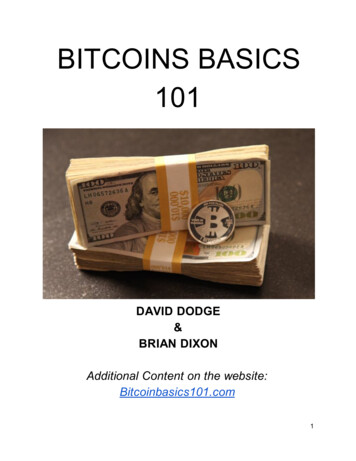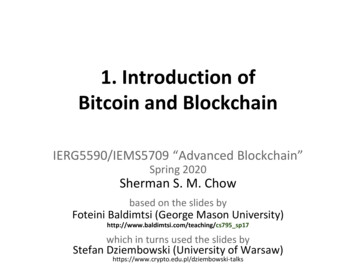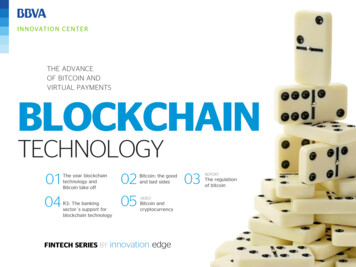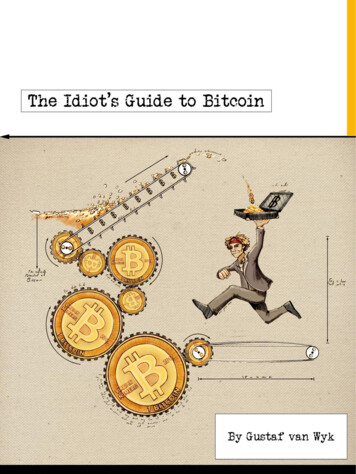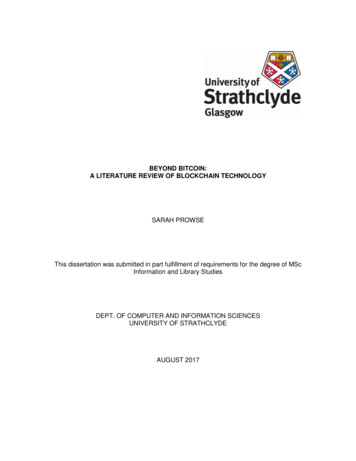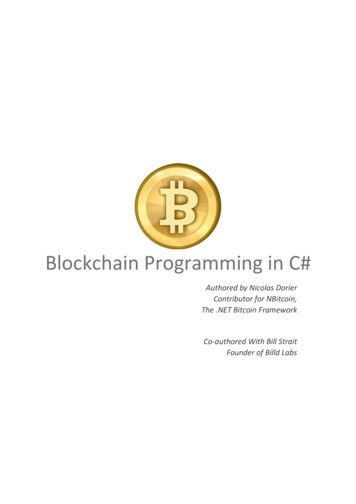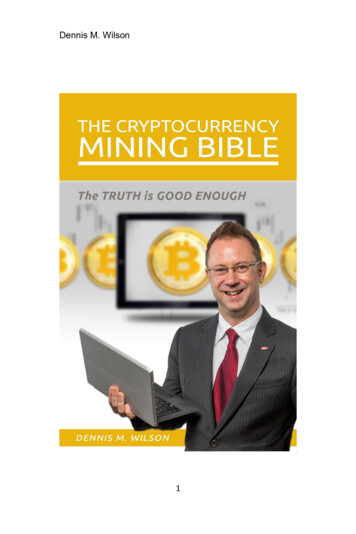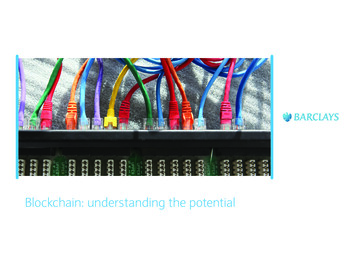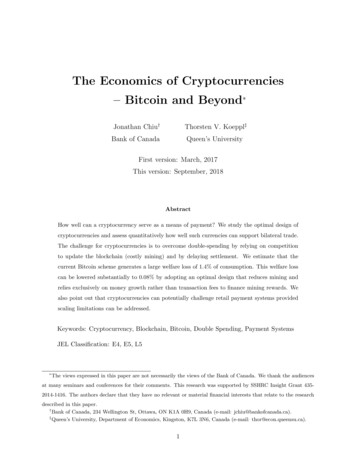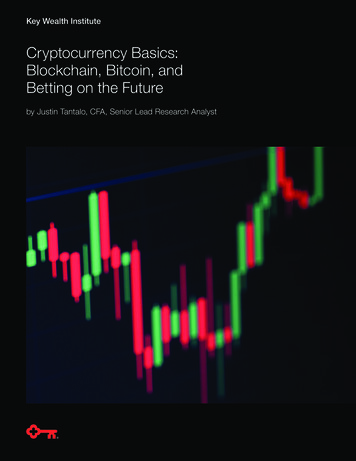
Transcription
Key Wealth InstituteCryptocurrency Basics:Blockchain, Bitcoin, andBetting on the Futureby Justin Tantalo, CFA, Senior Lead Research Analyst
Key Wealth InstitutePart 1: Bitcoin and blockchain basicsBitcoin was introduced on October 31, 2008, in a short message from Satoshi Nakamoto1 sent to anobscure mailing list of cryptography enthusiasts:The humble message linked readers to a nine-page white paper, where Satoshi outlined the Bitcoinpeer-to-peer payment framework and introduced a set of solutions to overcome the shortcomings ofprevious attempts at decentralized digital cash. The message represented the birth of a revolutionarytechnology — the decentralized digital blockchain — and, on that blockchain bitcoin, the world’s firstcryptocurrency.Who was Satoshi Nakamoto?We still don’t know. “Satoshi Nakamoto” was an alias used by the person (or persons) who developedBitcoin. The mystery around Satoshi is an intriguing side story in Bitcoin that could remain unsolvedindefinitely: It’s been more than 10 years since Satoshi Nakamoto was last active online. The mostcredible theories of Satoshi’s identity center on a small group of cryptography and computer scienceexperts, some of whom have passed on since Bitcoin went live in January 2009.What we do know from Satoshi’s writings is that he/she/they were likely motivated by a distrust ofthe fractional reserve currency system that underpins modern monetary policy. The fractional reservesystem places trust in a centralized monetary authority that ultimately controls money supply. Satoshibelieved that sound money could be created using cryptography and transparent code rather thancentral banks and politicians who might be subject to whims of the moment. Coincidently (or not), thetiming of Bitcoin’s launch (January 2009) coincided with the depths of the Great Financial Crisis and theultra-unorthodox monetary response to it. Satoshi embedded a message into the first block of Bitcoin:“The Times 03/Jan/2009 Chancellor on brink of second bailout for raphy/2008-October/014810.html1 Page 2 of 22
Key Wealth InstituteDefining BitcoinFirst, some terminology. The word Bitcoin — slightly confusingly — refers to two separate but relatedconcepts. It refers to both the blockchain network and the cryptocurrency that trades on that network.2Other blockchain protocols such as Ethereum differentiate the network (Ethereum) from the currency(ether) with less ambiguity.What is Bitcoin?Bitcoin is a decentralized, digital blockchain network that allows peer-to-peer transfer of value(bitcoin) without the need for permission or trusted intermediary. A bitcoin is not simply a filethat is sent from one user to another, since the sender could keep a copy while also spendingit (i.e., double spend). Instead, the Bitcoin network keeps track of all historical transactions ona distributed ledger to accurately reflect who currently holds bitcoins.Ledgers, ledgers everywhere!Banks, central banks, security brokers, remittance services, and countless other intermediaries makeup our modern-day centralized financial infrastructure. Collectively these entities maintain interconnectedledgers of who owns what and who owes what: They implicitly reflect historical transactions made betweenparties. It’s a complicated web of centralized ledgers that is costly to maintain, but the plumbing works.Digital blockchains like Bitcoin, on the other hand, operate as decentralized distributed ledgers wherenetwork participants propose, validate, and record transactions without a centralized, trusted intermediary.In Bitcoin, all transaction data is stored on a blockchain. A blockchain is a ledger record of everyhistorical transaction in the network, since day one, where “blocks” of data (transactions) are “chained”to previous blocks such that the blockchain tells a single, immutable story of how current balancescame to be. The ledger is append-only, which means that data or transactions can only be added insubsequent blocks. Cryptographic verification is used to ensure that transactions in historical blockscannot be altered without breaking the sanctity of the chain.How it works.The Bitcoin blockchain is software maintained concurrently on thousands of independent nodes (servers)distributed globally. Anyone can operate a node on something as basic as a personal laptop. Thisdistributed architecture makes Bitcoin both hard to shut down and secure, since a rogue or maliciousnode with false transaction data will have its record disregarded by the consensus of the thousands ofother nodes. Consensus is the ultimate truth.Each node maintains its own copy of the Bitcoin blockchain which is updated with a new block every10 minutes or so. Let’s walk through a simple example to better understand the process.A differentiation is sometimes made: “Bitcoin” with an upper-case “B” refers to the blockchain network protocol, while “bitcoin” lower-case “b” refersto the cryptocurrency itself. Think of a railroad analogy: the goods (bitcoin) travel on the rails (Bitcoin).2 Page 3 of 22
Key Wealth InstituteSuppose Alice would like to send two bitcoins to Bob. Alice creates a transaction request using Bob’spublic address, signs the request digitally using her private key that only she knows, and broadcastsher proposed transaction to the network of nodes. All newly proposed transactions like Alice’s aredistributed to each node. Cryptography is then used to verify that Alice sent the message and that thetwo bitcoins are in fact hers to send.Alice’s transaction only becomes “official” when it is included in the next block of the blockchain. Thislast step requires a consensus-building mechanism amongst nodes so that each of them has the samerecord with the same cadence. Consensus-building is undertaken by a specialized participant called aBitcoin miner.Understanding a bitcoin transactionSource: CBInsightsAnyone can mine Bitcoin.Miners race against each other to be first to solve a computationally challenging cryptographic puzzle,because with that solution (called “proof-of-work”), they win the right to package awaiting proposedtransactions (including Alice’s) into the next official block in the blockchain. The successful miner isentitled to newly minted bitcoin as a reward for solving the puzzle and formally creating the next block.3All nodes update their blockchain once a new block is mined by a miner; in the above schematic, Bobofficially takes custody of his two bitcoins in block 105.Bitcoin miners play an important role in building consensus and maintaining network integrity. Theincentives they face steer the blockchain to include only the set of transactions which have been verifiedas legitimate (digitally signed and unspent coins). How so? A miner who solves the cryptographicsolution but proposes a block with a fraudulent set of transactions will have their block rejected by thenetwork of nodes (due to unrecognized transactions), which leads to failing to achieve consensus andforgoing their associated reward of newly minted bitcoin.Every Bitcoin came into existence through the mining process just described. To close out our example,Alice may have originally acquired those two bitcoins she sent to Bob in one of three ways:1. She mined them2. She purchased them with fiat currency like US dollars or other cryptocurrency at a crypto exchange3. She acquired them in exchange for goods or services (i.e., accepted payment in bitcoin).These are the three ways one can acquire bitcoin: mine them, buy them, or trade for them.3Mining rewards are currently 6.25 BTC per block. Rewards started at 50 BTC per block in 2009, but halve every four years.Page 4 of 22
Key Wealth InstituteDigital scarcitySatoshi Nakamoto appreciated that for users to adopt Bitcoin, it needed to be grounded in sound moneyprinciples. Establishing trust would be difficult if an unlimited supply of bitcoin could be conjured up ina discretionary manner, a weakness Satoshi believed to be inherent with fiat money. To address this,the protocol dictates that new bitcoin awarded to miners follows a known trajectory with ultimate supplycapped at 21 million bitcoins.The supply of bitcoin is scheduled to grow at a decelerating rate until sometime in the year 2140, whenall 21 million bitcoins that will ever exist will have been mined.4 As of mid-2021, approximately 18.7 millionbitcoin have been mined.Bitcoin introduced the world to the concept of digital scarcity — a digital good with verifiably limited supply.History of Bitcoin Supply 0l–Ju09n–Jal–n–JaJu090.0Source: CoinmetricsIs bitcoin money?Livestock, salt, shells, cloth, leather, coins of copper, silver, and gold have all been used as money atsome point in history. Is bitcoin (or other cryptocurrencies) the future of money? Maybe.Money is a complex, societal construct. Some of history’s brightest economists have written treatiseson money that span hundreds of pages. We won’t take that liberty here. But to approach this questionobjectively, we remind ourselves of the three textbook roles of well-functioning money. Money should actas 1) a medium of exchange, 2) a unit of account, and 3) a store of value. It turns out that when viewedusing this objective lens, bitcoin is a relatively weak form of money. Consider:Bitcoin as a Medium of Exchange: Money should be widely accepted in exchange for goods and services. US dollars are widely acceptedbecause those dollars are widely accepted elsewhere. That circle of trust is exceptionally important fora medium of exchange. Bitcoin, although growing, are not yet widely accepted as a form of payment. Scalability issues. The Visa payment network handles an average of 1,700 transactions per second.Bitcoin can accommodate approximately seven transactions per second. There are side-chain or“layer two” solutions that can improve scalability, but using bitcoin to purchase a cup of coffee is notlikely anytime soon.Beyond 21 million bitcoins, miners will be incentivized by transaction fees paid by senders.4 Page 5 of 22
Key Wealth Institute Bitcoin settlement is final. A credit card transaction can be reversed through a chargeback. There isno such discretion in Bitcoin, and it is impossible for a payer to unilaterally reverse a transaction, evenif justifiable because of error or fraud. With Bitcoin, all transfers are final, including mistakes.Bitcoin as a Unit of Account: Money should be fungible and divisible into smaller units. Here, bitcoin scores well as 1) all coinsare equal and fungible, and 2) a coin can be divisible into a hundred-millionth unit called a “satoshi”(0.00000001 BTC). A unit of account needs price stability. Bitcoin is still far too volatile to reliably price goods. There aresome goods which can be purchased in bitcoin today, but these transactions are usually priced first in ahard currency like US dollars, then wrapped with the equivalent bitcoin price tag at the final transaction.Bitcoin as a Store of Value: A store of value refers to money’s ability to retain its purchasing power across both space and time. A good store of value over space (geographically) was first defined by neoclassical economist StanleyJevons as “Something which is very valuable, although of little bulk and weight, and which will berecognized as very valuable in every part of the world.”.5 Since bitcoin lives on a decentralized globalnetwork, it scores exceptionally well as a portable asset that stores value, arguably the best in history. H owever, money should be a good store of value over time too. Bitcoin’s volatility can easily be forgivenwhen prices are rising, but there have been three drawdowns of 80% in the past 10 years. The highvolatility materially limits the attractiveness as a store of value. Historically, stores of value duringeconomic and political duress (when they are needed the most) have been volatile given high levels ofuncertainty and risks of punitive capital controls. Given Bitcoin’s more limited history and much highervolatility, other assets such as gold may be more palatable for a broader range of people.Bitcoin has scalability issues and a volatility profile that makes it a weak form of transactional money.A better analogy for Bitcoin might be “digital gold.” Gold and bitcoin are both liquid,volatile, bearer assets whose incremental supply is verifiably constrained. There aresuperficial parallels too: Both bitcoin and gold are mined into the market, and bitcoinis even popularly portrayed as a golden coin, with an engraved B.GoldBitcoinFinite supplySupply increases about 2% per year.Supply increases less over time, with a terminallimit of 21,000,000 coins.Liquid marketsGold has a highly liquid market with a hugevariety of participants and contracts.Bitcoin, like gold, appears to have highly liquidmarkets, including futures contracts.*UncorrelatedCorrelations with other assets are typicallylow, especially in times of economic distress.Price behavior is still evolving, with correlationsincreasing more recently.Inflation hedgePast inflationary episodes have shown goldtends to perform well in such environments.Finite supply is attractive, but the asset remainsuntested given its limited history.Global acceptanceGold is a globally recognized store of value,held as reserve assets by most central banks.Bitcoin is banned in a number of countries andis widely regarded with skepticism by authorities.Use in goodsGold is commonly used in high-techmanufacturing and jewelry.Bitcoin has no uses outside its value as an asset.Source: Invesco*Bitcoin trades 24/7, resulting in periods of relative liquidity. This appears to be especially true on Sundays, resulting in greater price volatility on these days.Money and the Mechanism of Exchange, (New York: D. Appleton and Co. 1876)5 Page 6 of 22
Key Wealth InstitutePart 2: Crypto assets in a portfolioBitcoin is a cleverly designed peer-to-peerpayment network. But how does its technologyand growing adoption translate to price? In otherwords, what is a bitcoin worth?Consider the uncertainty of this question throughthe lens of bitcoin’s historical price range. It’senormous. At the bottom of the range, the10,000 bitcoins that Laszlo Hanyecz paid fortwo Papa John’s pizzas in 2010 implies a priceof less than 0.01 per bitcoin. At the top end ofthe range, in early 2021, one bitcoin traded forapproximately 65,000. From less than one centto 65,000 with exceptional price volatility alongthe way, it’s clear that even the wisdom of themasses struggle with bitcoin’s fair value.Bitcoin has no obvious intrinsic value. Anytheoretical model or narrative on the fair valueof bitcoin requires a good dose of abstraction.Unlike traditional assets like stocks, bonds, andreal estate, bitcoins do not have a stream of cashflows that can be discounted. How then shouldone think about bitcoin’s price and/or fair value?Bitcoin Price USD (Log Scale) 100,000 10,000 1,000 100 10 1Jan–11 0Source: CoinmetricsMarket participants have proposed various frameworks to understand bitcoin’s price. We review a fewof the most compelling here:Relative to goldBitcoin’s conceptual parallel to gold has been extended to valuation. If one considers gold as a financialasset and store of value and ignores its use in jewelry, electronics, and dental work, then comparinggold’s total capitalization to bitcoin could be informative. The World Gold Council estimates that 200k tonnes (or metric tons) of gold have been mined throughout history. Because gold is practicallyindestructible, we can assume that it is all still held somewhere. That gives gold a market capitalizationof approximately 12 trillion (at 1,750/oz). Using June 30, 2021, price (approximately 35,000/BTC),Bitcoin’s market cap of 650 billion values the asset at 5% of gold. Some gold-based valuation modelsalso adjust for bitcoin’s substantially higher volatility. If volatility is incorporated, then the relative marketcap to gold is materially higher.Page 7 of 22
Key Wealth InstituteBitcoin Relative to Gold (Total Market es: Coinmetrics, World Gold CouncilMetcalfe’s Law suggests that the value of anynetwork is nonlinearly proportional to the numberof users on it (value users2). In other words, thevalue of a network is equal to the square of itsuser base.Consider a simple telephone network with twousers. It has some value, but with three usersit has more than twice that value, since morethan twice as many combinations of calls canbe made on it.Proponents of this framework see Bitcoin asa payment network with growing adoption.Invesco evaluated this model using transactionpairs to proxy Bitcoin’s user base and plottedit against bitcoin prices over time.The challenge with this model is that Metcalfe’sLaw is rather vague about the definition ofvalue. Does it refer to the value (price) of asingle bitcoin in dollars? Does it refer to the10,000,000 100,000Price Per Bitcoin, USDModel #1: Using Metcalfe’s Law.Network Effects: Metcalfe’s Law1,000,000 10,000100,000 1,00010,0001,000 100100 10 1201110Transaction Pairs, MillionsBitcoin in relation to an exogenous marketprice like gold is one way to approach valuation.An alternative group of models attempt tounderstand bitcoin’s price endogenously, or itsprice in relation to internal variables. Three ofthese models are presented below.1201420172020Closing Price, USD (LHS)Transaction Pairs (RHS)Value of a Network # of Nodes2Sources: Bitcoin price and its marginal cost of production: support for afundamental value by Adam S. Hayes, CFA, and Metcalfe’s Law as a Modelfor Bitcoin’s Value by Timothy F. Peterson, CFA, CAIA. Model recreated usingestimates from Cambridge University Centre for Alternative Finance and datafrom CoinMetrics.io. Data as of 31 May 2021. Past performance does notguarantee future results.Charting produced by Invesco.value (economic utility) of the Bitcoin blockchainnetwork? The difference matters. Email as anetwork has exceptional value (utility), but it alsohas a comparatively low price.Page 8 of 22
Key Wealth InstituteModel #2: Stock-to-Flow.The Stock-to-Flow (S2F) model was first disseminated in 2019 by pseudonymous Bitcoin enthusiast“Plan B.” The model hypothesizes that a scarcity factor (SF stock/flow) explains price levels. Gold, forinstance, has a scarcity factor of approximately 66x (existing stock of 200 thousand tonnes, annualflow of three thousand tonnes), meaning that it takes approximately 66 years of current gold miningproduction to double outstanding gold supply.Bitcoin has a dynamic scarcity factor that increases over time as the new supply of bitcoin created bythe mining process halves every four years. An increasing scarcity factor was thought to drive priceshigher. Plan B fit a predicted value estimate through statistical regression, which is presented below.Stock-to-Flow Model (Log Scale) 1,000,000 1,000,000 100,000 100,000 10,000 10,000 1,000 uJa1718n–Ja17l–Jun–16Stock-to-Flow Model (BTC 0.4*SF l–n–JuJa13 012 011 012 1 011 110 1010 1009 10009 100BTC Price (USD)Sources: PlanB, CoinmetricsThe Stock-to-Flow model hypothesizes that a scarcity factor (SF stock/flow) explains price levels.The S2F model had exceptional out-of-sample success early on, which thrust the model and the authorfirmly into the spotlight. More specifically, when the model was released in March 2019, bitcoin wastrading at less than 4,000. The model predicted that post the May 2020 halving of mining rewards,from 12.5 per block to 6.25, the price of bitcoin would be close to 70,000, reflecting a higher scarcityfactor. A nearly 20x implied return was a bold prediction indeed. And it was surprisingly prescient: Theprice of bitcoin rose more than 15x to 65,000 by early 2021.Academics tend to dismiss the S2F model on the grounds of the efficient market hypothesis. Theyargue that the future supply trajectory of bitcoin is known in advance, and thus it should already bepriced in. In fact, bitcoin supply has almost no uncertainty to it (it’s transparent code). Fluctuations indemand, which are variable, should thus matter more than widely understood incremental supply. Inshort, academics dismiss the S2F model as a classic case of mistaking causation for correlation.Page 9 of 22
Key Wealth InstituteModel #3: Marginal Cost.Embodied Costs of ProductionThe final model to note was proposed by AdamHayes, who borrows from neoclassical economicsand suggests that the price of bitcoin might berelated to its marginal cost of production, or atleast provide a floor. The marginal cost of bitcoincomes in the form of energy and computingequipment that miners use, since that is theprocess by which new bitcoins enter the system.Haye’s thesis is this: The higher the cost of miningbitcoin, the higher its price should be.The challenge with this model is that unliketraditional commodities, incremental supply ofbitcoin does not respond to expanded miningcapacity. Bitcoin’s protocol automatically adjuststhe difficulty of the cryptographic mining puzzlesuch that regardless of network-wide hash-rate(i.e., mining capacity), a new block is created onaverage every 10 minutes. The math adjusts andthe puzzle gets harder to solve. Since no amountof computing power can change the rate ofincremental bitcoin supply, marginal cost arguablyconverges to price, not the other way around.Cost of Production Electricity Cost of Hash RateBitcoins Mined Per DaySources: Bitcoin price and its marginal cost of production: support for afundamental value by Adam S. Hayes, CFA, and Metcalfe’s Law as a Modelfor Bitcoin’s Value by Timothy F. Peterson, CFA, CAIA. Model recreated usingestimates from Cambridge University Centre for Alternative Finance and datafrom CoinMetrics.io. Data as of 31 May 2021. Past performance does notguarantee future results.Charting produced by Invesco.Haye’s thesis says that the higher the cost of mining bitcoin, the higher its price should be.Investors have long struggled to describe or predict the price of unproductive assets whose cash flowscannot be simply discounted. Warren Buffett, arguably the most-famous investor in history, is wellknown for being uninterested in gold precisely because it yields nothing, and suggests that the asset isnot useful outside of “going long fear.” In his 2011 letter to Berkshire Hathaway shareholders, he wrote:“What motivates most gold purchasers is their belief that the ranks of the fearful will grow.”The reality is that there is no theoretical model that reliably captures bitcoin’s price. No reliable modelindicating whether its price is low, fair, or expensive. Bitcoin has value because humans ascribe it value.Like gold. And just like gold, there is no endgame with bitcoin’s price discovery; it will continue to be avolatile reflection of speculation, fear of inflation, fear of missing out, risk of regulatory intervention, riskof technological obsolescence, and ultimately, buyer’s sentiment.Bitcoin in a portfolioInstitutional and private investors are increasingly incorporating bitcoin and other crypto assets into theirinvestible opportunity set. The asset class is relatively new and volatile, but high risk-adjusted returns havecommanded attention. In this segment we’ll review the characteristics of bitcoin in an investment portfolio.Page 10 of 22
Key Wealth InstituteWe’ll start by stating the obvious: Bitcoin is an exceptionally volatile asset. The standard deviation ofreturns for bitcoin averaged 75% over the past five years. That is more than twice the volatility of crudeoil, 5x the volatility of gold and US equities (S&P 500 Index), and more than 20x the volatility of USinvestment-grade bonds (Barclay’s Aggregate Bond Index).Annualized Return Volatility (Trailing ��17Jul–17Jan–18BitcoinBBgBarc US Treasury IndexGoldJul–18Jan–19Jul–19Traditional 60/40S&P 500 IndexJan–20Jul–20Jan–21BBgBarc US Agg Bond IndexBrent CrudeSources: Coinmetrics, MorningstarDrawdowns in bitcoin prices are shown in the figure below. Over the past 10 years, bitcoin has lostnearly 80% of its value on three separate occasions. Enthusiasts have even coined an acronym for it:HODL — hold on for dear life. In each of those drawdowns prices rebounded to record new highs overthe coming years.Bitcoin Price 1May–11-90.0%BitcoinSource: CoinmetricsPage 11 of 22
Key Wealth InstituteDespite this history of volatility and aggressive drawdowns, bitcoin’s returns have more thancompensated, resulting in a stream of historically high risk-adjusted returns. The trailing one-year Sharperatios are shown below. As a reminder, the Sharpe ratio compares an asset’s excess returns (over therisk-free rate) to its volatility (standard deviation of returns). Higher is better.Sharpe Ratio (Trailing 12m)5.04.03.02.01.00.0-1.0BitcoinS&P 500 IndexBbg-Brcly US Aggregate Bond Index1–220arM20c–De20p–0GoldBbg-Brcly US Treasury n–16-2.0Traditional 60/40Brent Crude OilSources: Coinmetrics, MorningstarBitcoin return correlations with traditional assets for the past decade are shown in the matrix below.BitcoinUSD60% FTSEAll World 40% USBonds (IG)BBgBarcUS AggBondBBgBarcUSCorporateHigh YieldBitcoin USD1.0060% FTSE All World 40%US Bonds (IG)0.11BBgBarc US Agg Bond0.000.111.00BBgBarc US Corporate High Yield0.120.850.201.00(0.04)(0.27)0.88(0.23)BBgBarc US TreasuryBBgBarcUS S&P 500TreasuryRussell2000FTSEFTSEFTSEDvlpNareit BloombergEmergingMrktsAll Equity CommodityMarkets(ex oldMetals1.001.00S&P 5000.140.95(0.07)0.77(0.41)1.00Russell 20000.120.84(0.15)0.75(0.47)0.891.00FTSE Dvlp Mrkts (ex US)0.110.96(0.03)0.80(0.39)0.880.801.00FTSE Emerging Markets0.040.870.090.78(0.27)0.740.680.851.00FTSE Nareit All Equity berg .371.00S&P GSCI Brent .731.00S&P GSCI 0.081.00S&P GSCI Industrial 440.500.370.650.440.240.45S&P GSCI SoftsS&PGSCISoftsSources: Coinmetrics, MorningstarThe slightly negative correlation with gold is worth noting. If the narrative is that bitcoin is “digital gold,”shouldn’t the correlation be higher? Or positive? One potential explanation is that as an investmentsubstitute for gold, bitcoin may be drawing incremental demand and capital away from bullion.Page 12 of 221.00
Key Wealth InstituteOverall, bitcoin has negligible return correlations with traditional assets.Analyzing bitcoin’s price volatility using the Venn risk model designed by Two Sigma confirms theidiosyncratic nature of bitcoin’s volatility. Less than 10% of volatility can be explained by commonfactors. The remaining 90% is residual and unexplained, which is consistent with the low correlationsshown in the matrix on the preceding page.Factor Contributions to RiskWhat percent of total risk is driven by each CreditCommoditiesEmerging MarketsLocal InflationLocal EquityEquity Short VolatilityFixed Income CarryForeign Exchange CarryTrend FollowingLow 0%Two Sigma’s factor selection methodology excluded 4 insignificant factors. Negative Positive Insignificant Value ResidualSources: Two Sigma Venn, CoinmetricsAssets with high risk-adjusted returns and low correlations with stocks and bonds are the holy grail inmodern portfolio theory. Including these assets in a diversified portfolio pushes out the efficient frontierand increases the benefits from diversification. The challenge, of course, is determining whether thehigh and uncorrelated historical returns of bitcoin persist.The “easier” forecast to make is that one should expect correlations with traditional assets to rise overtime as institutional adoption of bitcoin and crypto assets increase.Allocation sizingDigital assets are new to most portfolios. Investors should consider the risks involved, which we discussin the next section, but recognize that these assets represent the next layer of a digital transformationthat’s been taking place over the past 30 years. It’s been a costly theme for investors to ignore.An investment in bitcoin (or any digital asset) should be sized appropriately in a portfolio. Bitcoin’s lowcorrelations with traditional assets help, but ultimately the only real mitigant to 75% volatility is to size theallocation accordingly. And for the avoidance of doubt, while bitcoin is statistically uncorrelated to mostassets, it is not a portfolio hedge. During meaningful drawdowns in risk assets, bitcoin declines too.Page 13 of 22
Key Wealth InstituteBitcoin During S&P500 Drawdowns (10% P
The Bitcoin blockchain is software maintained concurrently on thousands of independent nodes (servers) . Understanding a bitcoin transaction Source: CBInsights 3 Mining rewards are
